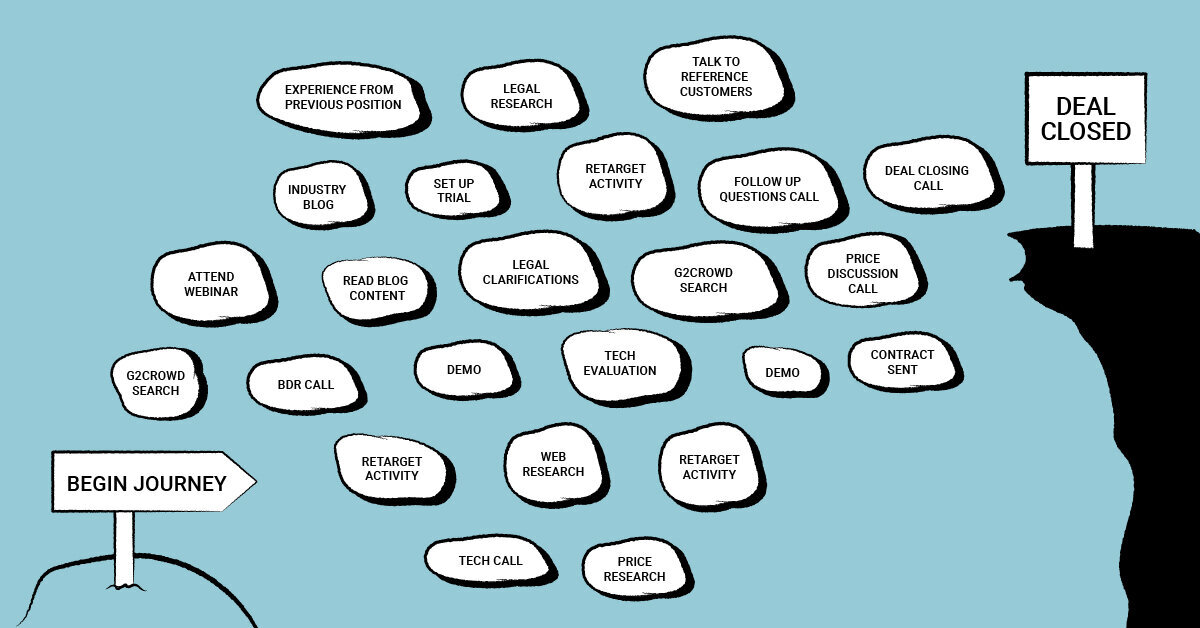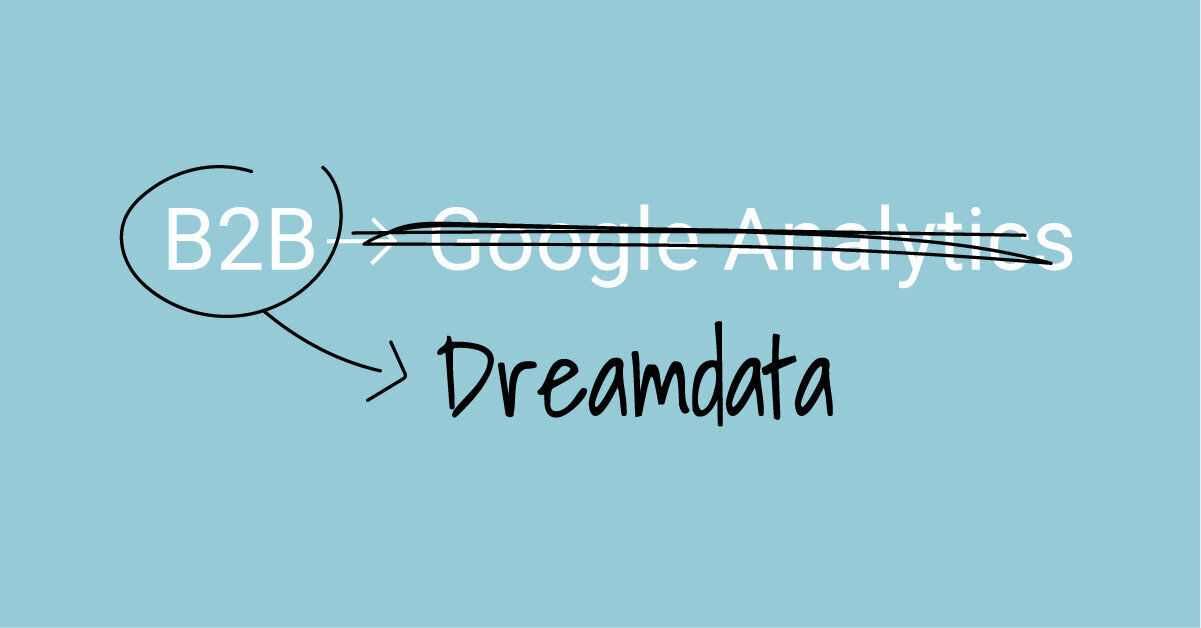Why B2B companies should stop using Google Analytics as their data-compass for growth
Let’s face it: too many B2B companies are still incorrectly relying on data from Google Analytics (GA) to point them in a direction they can trust.
In this post we explore this old world of Google Analytics and discover the new world for overcoming B2B’s challenges. You’ll learn:
Three reasons why Google Analytics is inadequate in the B2B context;
GA tracks individual devices not accounts
GA can’t handle multiple stakeholders and long user journeys, and,
GA can’t help track revenue outside the website, lifetime value of ads, nor apply attribution
What needs to happen to overcome GA’s limitations in the B2B context
What your next steps should be
Setting course
For a long while Google Analytics reigned uncontested. It was one of the only options out there if you wanted to understand what happened on your website. It was even free. At least in a monetary sense.
But things have changed. Oh how things have changed.
The single-device landscape in which Google Analytics was born is radically different than how the landscape looks nowadays.
Sure, if you’re looking at siloed data points or simplified website metrics, GA is great.
But siloed data points are not meaningful for B2B marketers trying to uncover how their efforts are impacting revenue.
Sales cycles are lengthy, many stakeholders are involved, and touchpoints are a pain to attribute to users and accounts with certainty.
Which means, sticking with GA as your data-compass for growth can lead you completely off course, in spite of your convictions and best intentions.
Take Christopher Columbus, for example. Yes, that Christopher Columbus. Navigator extraordinaire, right?
Wrong. Even though he’s known for discovering the New World (the Americas), he didn’t even realize he discovered it.
The man was so stubborn, he insisted he’d landed on the Chinese coast… when in fact his voyages brought him to Cuba, the Caribbean, and the Americas. So not even close to China.
Unimpressed with his inaccurate findings, Columbus’ investors eventually ended up pulling his funding.
The moral of the story? Don’t be like Columbus. Or, in other words, don’t cherry-pick data and focus on vanity metrics that only service to confirm your assumptions. You simply need tools that are meant and built for B2B.
To his defence, Columbus only had the sun, moon, and stars to guide him.
If he was alive today and had the choice between an outdated map (that’s been hanging on the wall for ages) or a state-of-the-art GPS system that continuously updated and kept him perfectly on course, which one would he go with?
Seems like a no-brainer. So why do so many B2B companies still rely on the outdated map that is Google Analytics?
There are a few possible explanations:
it’s what they know;
it’s what everyone else uses;
it’s taken a lot of time (and money) to hack so the data has to be trustworthy…right?...
But let’s face it, you’re still trying to force a square peg into a round hole. And if the round hole is all you know, it makes sense that you’re reluctant to get rid of it.
From choppy waters to smooth sailing ⛵
At the very least, you’re not the only one struggling with this. Most SMEs and SaaS companies still turn to Google Analytics, in spite of it being an often frustrating experience with a steep learning curve and unreliable data.
We get it. It can be demotivating to spend a lot of time and effort understanding and setting up GA to work for you, only to realize it’ll never give you the full B2B picture.
It’s like trying to open a can of soup with a knife. You might be able to do it, but it’ll take longer, the experience will be messy and frustrating, and you’ll probably cut yourself in the process.
What it comes down to is this. You have to:
Accept that GA consists of data that will never be able to give you the full 360-view of where you need to buckle down on your B2B marketing activities and,
Understand that if your company doesn’t clearly define what the right metrics to use are, no tool or platform is going to get you the data you need to stop wasting money and repeat success.
Find a tool that is intended for B2Bs only.
Seeing as you’ll have to think about your metrics in a completely new way, how do you bring up this touchy subject in your company?
How do you avoid being left without the proper data to make informed decisions?
How do you pivot from B2C metrics and assumptions, to actual B2B results you can trust, understand, and (most important of all) repeat?
We’ve got you covered.
This blog will go through some of the main reasons why GA is not the right fit for B2B growth, and help you on the way to getting a true 360-view of your marketing impact on revenue.
1. Google Analytics tracks individual devices, not accounts
Cisco (a global leader in IT, networking, and cybersecurity solutions) has predicted that the average person will own up to 13 devices that are connected to the internet by 2022.
Already now, you’ll find it challenging to connect devices and goals to one and the same user.
It means by default Google Analytics gives you a skewed view of your data, e.g. a person with a computer and a phone will look like two different individuals despite them being part of the same customer journey.
If you’re selling a running shoe, this is a problem.
If you’re selling a complex B2B product this is a nightmare. Currently B2B marketers are depending too heavily on analytics data sourced on an individual device level; offering only a very limited representation of what’s actually going on.
What GA does allow you to do, is create conversion goals. This is a generic way of connecting the tracked devices to a wanted outcome.
Here we’re talking about actions like:
A sign-up up for a webinar
A filled-in form
A downloaded PDF
Etc.
The problem though, is you can’t connect those goals to a person, an actual individual user. You can’t go granular. And this is the whole point. You can’t repeat success and stop wasting if all you have are generic numbers on actions from disjointed devices.
You need to understand all the touches of all the accounts. And, you need to build a graph of all devices associated with an account.
Yikes, right? So it’s no wonder it’s difficult to figure out which one of your efforts is actively paying off, and why, so any chance of repeating success is based on guesswork.
2. Google Analytics can’t handle multiple stakeholders and long user journeys
It’s very likely that two or more stakeholders will be part of buying your B2B service or product.
But when the torch passes between two people, Google Analytics is completely lost. It doesn’t know that torch is representative of one and the same account, so you end up with gaps all over the place.
Not exactly ideal for optimizing the touchpoints and user journeys that perform well. It also makes it unfairly difficult to identify where things may even go haywire in your marketing.
You need an account-based view to be able to rely on the data you’re looking at.
On top of that, B2B sales cycles can easily last for many months after the first touchpoint (demo, trial, negotiations, what have you).
This is a huge element of B2B attribution that not enough people take into account: time to revenue. Or, in other words, how long it takes from the first time somebody from a potential account visits your website until the account is closed as won.
For that, you need the memory of an elephant.🐘 Something that never forgets, and that remembers (in technicolor) when that first visit happened.
Google Analytics does not have the memory of an elephant. It has the memory of a goldfish. It only allows you to track up to 90 days prior to whatever conversion goals you set up and connected to your touchpoints.
Basically, if you have a sales cycle that’s longer than 3 months (which is the case for most, if not all, B2B scenarios), you’re only ever going to see part of the map and risk ending up dead in the water (or discovering the wrong coastline!).
3. Revenue, lifetime value, and attribution
Forget about it.
No, really. If you want to be accountable for these three pivotal aspects of your marketing efforts, Google Analytics is not the one.
Ideally, marketing spend should be assessed by the revenue it generates. And in most B2Bs, revenue is generated when a salesperson signs a deal with a customer, and primarily tracked in a CRM.
Google Analytics has no insights into this process, nor the revenue that’s made. This means that your marketing spend’s contribution to revenue has no chance of being fairly measured and presented in Google Analytics.
The same goes for lifetime value (LTV). For most B2Bs, all growth activities depend heavily on the LTV part of the equation to make positive return on investment (ROI). Unfortunately, you can't see LTV in GA, either.
So that’s two big pieces of the B2B puzzle unaccounted for. Two pieces that are absolutely vital if you want to dive into the wonderful world of revenue attribution.
Google Analytics on its own will simply not get you the full picture you need to keep perfectly on course.
Which leads us into our final beef with GA.
Learn more on why we ditched Google Analytics.
Think like Columbo, not Columbus! 🕵️♂️
The importance of making data-driven decisions is something we can all agree on when it comes to successful digital marketing.
But without analytics and attribution properly set up, you’ll never be able to understand the full value of your actions.
And using Google Analytics on its own is not enough for marketers to uncover how much revenue they’re generating with each digital campaign.
This is especially true for B2B companies, where a detailed view of conversion paths is complicated by the length of sales cycles and the amount of stakeholders involved along the way.
Transparency is lost, and it’s hard to tell North from South and East from West.
It’s little wonder marketers often find themselves turned around (a la Columbus)!
So now it’s time to change course and stop thinking like Columbus, and more like Columbo (you know, the beloved television detective from the 70s).
As opposed to Columbus, Columbo always followed the truth and let the right data guide him in the right direction.
He asked the right people the right questions and considered all sides of the same story, so in the end he discovered the real truth (as opposed to being led by vanity metrics).
Put on your data detective hat 🔎
You might have difficulty getting a hold of Columbo, but you can play detective yourself with our Deal Inspector: a tool that lets you see exactly what all of the contacts on an account did leading up to the deal.
What you should do next
Look into ways to start storing your own raw data from every department
Identify every tool and piece of software your departments are using
Implement tracking software or tools for any activity or touchpoint you’re not actively measuring yet
Start tracking your users (we recommend using Segment)
Want to give it a go yourself ?
Then check out the step-by-step details of our technical recipe to revenue attribution.
Put in the work, and you’ll not just end up with a data-compass you can rely on… but a state-of-the art data-GPS that gives you a holistic reflection of the actual B2B customer journey in your company.




